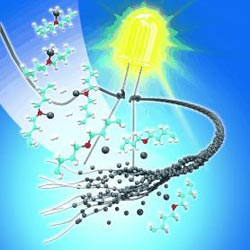Wearable Electronics

<br>
Jackets with built-in mobile phones, sports clothes that warn you when your heart rate gets too high, wallpaper with glowing patterns—these are not concepts from a science fiction movie, some of them are actually already available, and they may soon become commonplace.
These applications require electrically conductive fibrous materials. Korean researchers have now developed a new process for rendering paper and textile fibers conductive with aluminum. Their report appears in the journal Angewandte Chemie.
Conventional silicon-based electronics are actually not very well-suited to wearable devices because they are brittle, cannot be bent or folded, and must not fall onto a hard surface. This makes “wearable” electronics unthinkable. But they would not just offer opportunities for fun and games, they could also be useful in many areas. They would allow the bodily functions of at-risk or chronically ill patients to be monitored without requiring them to walk around with cables attached to them.
A baby’s sleepwear could sound an alarm if its breathing stops. “Intelligent” protective clothing could constantly indicate the position of field personnel by radio. Textile and paper electronics would also be ideal for novel large-scale interior design elements and security features in buildings.
These types of applications all require a flexible but conductive material that can be applied to a flexible substrate in the form of electronic circuits. Current techniques like printing or vapor deposition are not applicable to fibrous materials because it is not possible to produce a continuous pattern. In addition, these methods are very expensive.
Researchers led by Hye Moon Lee at the Korea Institute of Materials Science and Seung Hwan Ko at the Korea Advanced Institute of Science and Technology have now developed a simple, affordable approach for making conductive textile and paper fibers with aluminum. The paper or textile fibers are first pre-treated with a titanium-based catalyst and then dipped into a solution of an aluminum hydride composite solution. The catalyst is needed to allow the subsequent conversion of the aluminum compound to metallic aluminum to occur at room temperature.
The materials are not simply coated; in fact their fibers absorb the solution. This means that they do not have just a surface layer of aluminum, but are fully saturated. This produces papers and textile fibers with excellent electrical conductivity that can be bent and folded as desired. They can also be cut to any desired shape and size and simply glued or sewn onto an equally flexible support.
About the Author
Dr Hye Moon Lee is Principal Researcher at the Powder & Ceramics Division at Korea Institute of Materials Science and has been working in the preparations of functional nanoparticles and inks for printed electronics for about 10 years. His research is in the area of metallic inks and fabrication of functional electrodes for flexble, stretchable, and wearable electronics with these inks.
Author: Hye Moon Lee, Korea Institute of Materials Science, Changwon (Rep. Korea), mailto:hyelee@kims.re.kr
Title: Highly Conductive Aluminum Textile and Paper for Flexible and Wearable Electronics
Angewandte Chemie International Edition, Permalink to the article: http://dx.doi.org/10.1002/anie.201301941
Media Contact
More Information:
http://pressroom.angewandte.orgAll latest news from the category: Materials Sciences
Materials management deals with the research, development, manufacturing and processing of raw and industrial materials. Key aspects here are biological and medical issues, which play an increasingly important role in this field.
innovations-report offers in-depth articles related to the development and application of materials and the structure and properties of new materials.
Newest articles

High-energy-density aqueous battery based on halogen multi-electron transfer
Traditional non-aqueous lithium-ion batteries have a high energy density, but their safety is compromised due to the flammable organic electrolytes they utilize. Aqueous batteries use water as the solvent for…

First-ever combined heart pump and pig kidney transplant
…gives new hope to patient with terminal illness. Surgeons at NYU Langone Health performed the first-ever combined mechanical heart pump and gene-edited pig kidney transplant surgery in a 54-year-old woman…

Biophysics: Testing how well biomarkers work
LMU researchers have developed a method to determine how reliably target proteins can be labeled using super-resolution fluorescence microscopy. Modern microscopy techniques make it possible to examine the inner workings…





















